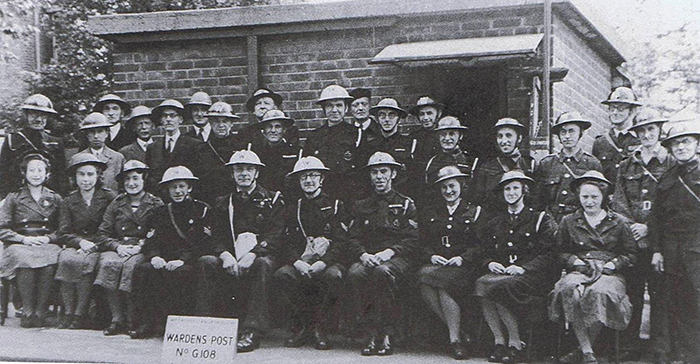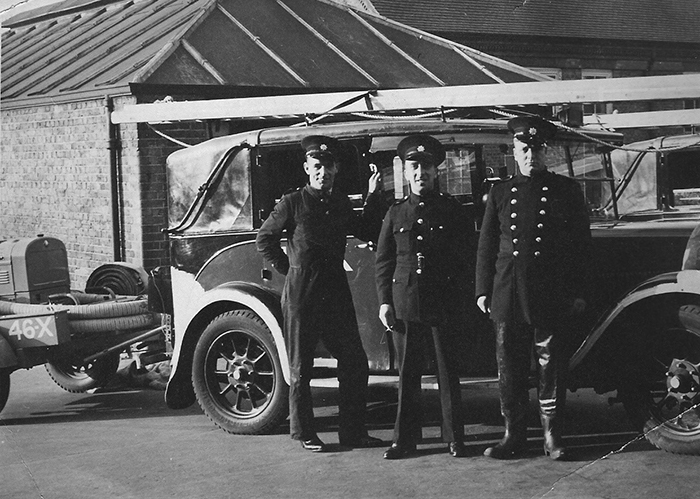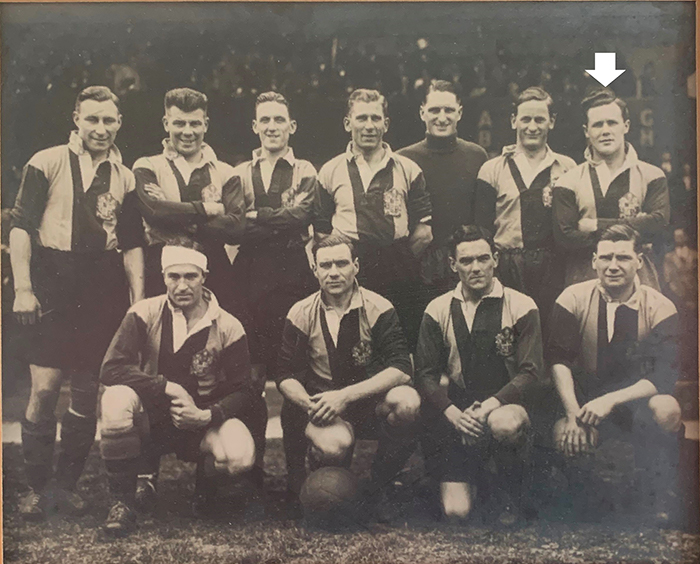They Also Served - Dulwich Hamlet's Civil Defence Workers
20/04/2020 - 2.58
Stephen Hunnisett
When thinking about football and footballers in wartime, we are perhaps automatically drawn to those players who joined up to serve with the armed forces and especially those who paid the ultimate price. Many of the posts on this blog have rightly concentrated on this aspect. However, during the Second World War, there was another avenue available for those who wished to serve their country but were perhaps too old to “join up” or for personal or conscientious reasons felt unable to put themselves in a position where they might have to take lives but were more than willing to serve their country in another way.
The Civil Defence organisation – before August 1941 known as the Air Raid Precautions, or ARP Service – provided this opportunity and at Dulwich Hamlet, several of the club’s officials, players and one other former player decided to volunteer their services in this way.
Perhaps thanks to generations of us watching “Dad’s Army” on television, mention of the ARP Service tends to lead us to the character of Chief Warden Bert Hodges, frequently the nemesis of Captain Mainwaring who seems to revel in shouting at the hapless citizens of Walmington-on-Sea to “PUT THAT LIGHT OUT!”

Pictured: ARP Wardens at Lewisham (author’s collection)
The Air Raid Wardens’ Service had been founded in 1937 as a direct result of the threat of war from Germany and by the declaration of war in September 1939, some 800,000 had been recruited and these numbers were to swell greatly during the early months of the war. The vast majority of wardens were paid their expenses only and were part-timers, with the only full-time paid wardens being those more senior posts within each borough. About one in six wardens were female and as can be seen from the photo, many of them were citizens of a “certain age”. Their main tasks were to enforce the blackout, which they would do vigorously by patrolling a given “beat” from the network of Wardens’ Posts established across each borough but during times of air raid warnings being in force, they would continue to patrol and would then become control officers who would co-ordinate the response required to individual bomb incidents.
During the early war (“Phoney War”) period, their zealous enforcement of the blackout regulations earned the contempt of some members of the public and one long-running gag, cultivated by the music hall comedian Bud Flanagan, was that ARP didn’t actually mean Air Raid Precautions but rather stood for ‘Anging ‘Round Pubs!
With the coming of the Blitz in September 1940, attitudes began to soften, as most members of the public appreciated that the wardens were for the most part, hard-working volunteers, doing their bit to defend their local neighbourhoods in the best way they could.

Pictured: DHFC Group Photo 1933 – 1934 with Clegg & Garratt highlighted (Dulwich Hamlet FC)
Dulwich Hamlet’s contribution in this field was two-fold, as both Honorary Secretary and Honorary Treasurer stepped up to serve as wardens. Harold Clegg was a Yorkshireman, born in Sheffield on 10 March 1884, who had joined Dulwich Hamlet as a player in 1911 and had been appointed club captain for the 1914-1915 Season. During the Great War, he had served with the City of London Police as a Special Constable and upon his retirement as a player, had become a member of the club’s Management Committee and by 1934, was also the club’s Surrey FA Council representative. He was also the club’s Honorary Secretary, which he would have been able to fit around his duties as a General Manager for a stationers and publishing company. Harold lived in Cheam and so joined his local ARP Wardens’ service, with whom he served faithfully and energetically until ill-health forced his retirement in 1942. He also stood down as the club’s Honorary Secretary at this time and though he was reported as having made a full recovery, it would appear that his health remained fragile, as he did not resume his duties. Harold Clegg passed away in 1955, aged 71.
The club’s Honorary Treasurer Alf Garratt was a Dulwich resident, who lived quite close to the ground at 100 Turney Road and duly volunteered to serve with the Camberwell ARP Wardens’ Service, based at Post 61 at nearby Goodrich Road. He served throughout the early stages of the war but sadly, it would appear that he too suffered from ill-health, as his death was reported in 1944 at the relatively early age of 58.
In addition, we know of at least two others associated with the club who served as Wardens in Camberwell – these were Richard and Pyarea Adams, who were the parents of wartime player and Arnhem casualty Alan Adams. At the time of Alan’s death in September 1944, Richard was mentioned as having been a volunteer referee for some of the Junior Teams’ matches on the Greendale pitch.
The other high-profile arm of the Civil Defence Service and one which caught the imagination of the public far more than the ARP Wardens was the Auxiliary Fire Service. The AFS was established at the same time as the Wardens’ Service in 1937 but although they were also an all-volunteer force, unlike the Wardens, recruits to the Fire Service were paid on account of their role being deemed a full-time one, whereas the bulk of the work done by ARP Wardens was done at night. They were paid the princely sum of £3/5s a week (£2 for women), which wasn’t great money, even by 1940s standards but which compared favourably with Private Soldiers in the British Army, who were paid 2/6 per day at this time.

Pictured: Typical Group of AFS Firemen (author’s collection)
Recruits to the Fire Service were exempt from being called up into the Armed Forces, which meant that a good number of Conscientious Objectors were recruited, as well as older members of the public, who were still fit but who wanted to help defend their local neighbourhoods. Like the Wardens, the firefighters attracted hostility during the “Phoney War” period – “£3 a week Army dodgers” or “£3 a week to play darts” were just some of the insults hurled their way. They also attracted a certain amount of distaste and sometimes sexism from the regular firemen, who viewed them as amateurs and disliked the idea of women doing their jobs, even though the women were employed (officially) as telephonists, messengers and on clerical duties. Because the fire service tended to reflect the demographic of their local areas (in some parts of London, the Fire Service had something like a 90 percent Jewish take-up), there was also a certain amount of racism and anti-Semitism that had to be dealt with. Once again though, public attitudes quickly changed with the onset of the Blitz and especially when Churchill described the firefighters as “Heroes with grimy faces.”

Pictured: DHFC Team 1937 – 1937 with Bert Humphreys highlighted (Dulwich Hamlet FC)
Dulwich Hamlet had at least one recruit to the Fire Service during the war. This was Bert Humphreys, born on 2 May 1904, who had joined the club in 1932 from Hamptonian FC and who for the most part, was a fringe First Team player. Bert played most of his football for the Reserve and ‘A’ teams but did appear 30 times for the First XI, scoring two goals, with 20 of those appearances coming in the 1937-38 Season. He lived at Nelson Grove Road in Merton and in the 1939 Register, his occupation was described as a plasterer but he was also noted as being a member of the ARP Rescue Squad, another very important constituent part of the Civil Defence Service.
The Rescue Squads were specialists who would assess buildings and as the name suggests, rescue those trapped and injured, or recover bodies where necessary. From 1941, Rescue Squads were split into ‘HR’ Heavy Rescue Squads, that had specialist heavy lifting and digging equipment and ‘LR’ Light Rescue, who would employ sniffer dogs and use hand tools and often crawl into extremely confined spaces to rescue victims.
Bert transferred to the AFS, later the National Fire Service in 1940 and according to a December 1944 programme, appears to have been released from the service around that time, by which time he had passed his 40th birthday. We haven’t been able to ascertain exactly in which local Fire Service Bert served – he does not appear in the London Fire Brigade records and we can only assume that he served in the Merton & Morden AFS, although it is not possible to be one hundred percent certain about this as their records have not survived the test of time.
Out of interest, the other players in this team group all served in various capacities during the war, including two who appear on our Roll of Honour.

Pictured: Edgar Kail (Dulwich Historian)
It is almost impossible to write about Dulwich Hamlet without mentioning the legendary Edgar Kail. Born in Camberwell on 26 November 1900, Edgar played his first game for the Hamlet as a fifteen-year-old in 1915 and went on to enjoy a fourteen-year career for the club, scoring a staggering 427 goals in that time, including a club record 53 goals in the 1925/26 Season. A committed amateur, he was the last non-league player (although not the last amateur) to play for the full England side, making three appearances and scoring twice (both on his debut against France in 1929). He retired in 1933 and by the time of the 1939 Register being taken, was “mine host” at the White Hart Inn, Castle Combe, Wiltshire. Too old to be called up, Edgar’s part in the war effort was to volunteer to serve as a War Reserve Constable in the Wiltshire Constabulary. His official Police record shows his Police Station as being the White Hart Inn, so it would appear that he didn’t have to do much travelling to get to work. Interestingly, Edgar had returned to Dulwich Police Station to undertake his War Reserve training and upon completion of this, returned home and transferred to the Wiltshire force as WRC644 Edgar Kail!
Life as a War Reserve Police Office in the countryside would no doubt have been fairly quiet but towards the end of his service with the Wiltshire Constabulary, Edgar had the chance to prove his worth. Shortly before midnight on 13 March 1944, a Short Stirling bomber of 75 (NZ) Squadron, Bomber Command from RAF Mepal in Cambridgeshire, which was heavily laden with five naval mines for an intended minelaying mission off the occupied French port of Brest, attempted an emergency landing at the nearby airfield at RAF Castle Combe. The aircraft overshot the short runway at this airfield, which was normally only used for training purposes, ploughed through the perimeter fence and immediately caught fire. Fortunately, the seven-man crew under the command of New Zealander Pilot Officer Colin Baker, managed to escape but in the ensuing fire, the aircraft was written off and more importantly, three of the five mines on board, each contained a tonne of explosives, detonated. PC Kail was quickly on the scene and ensured that the area was safely evacuated and that no civilians were near the burning aircraft.
On 18 March 1944, Edgar received a commendation from the Chief Constable of Wiltshire “For the most efficient manner in which the situation at Upper Combe was handled during the early hours of 14 March 1944, when a heavy bomber laden with sea mines crash landed near the village.”
This was a fine way for Edgar to draw a line under his Police service, for with victory assured, the War Reserve force soon began to be wound down and he officially left the force on 9 October 1944.
Biography

Steve is now a full time Battlefield Guide, military history blogger and researcher, specialising in the Home Front and London at war in particular, who took the plunge into self-employment in 2015. He is a Southeast London boy by birth and splits his football watching time between Charlton Athletic and Dulwich Hamlet FC, being a season ticket holder at both clubs. He has developed a great interest in the history and heritage of both these community-oriented clubs and is the author of ‘For Freedom’, which tells the story of Dulwich Hamlet’s Second World War casualties


/prod01/wlvacuk/media/departments/digital-content-and-communications/images-2024/240328-Varsity-Line-Up-Resized.jpg)
/prod01/wlvacuk/media/departments/digital-content-and-communications/images-18-19/220325-Engineers_teach_thumbail.jpg)
/prod01/wlvacuk/media/departments/digital-content-and-communications/images-2024/240515-Spencer-Jones-Award-Resized.jpg)
/prod01/wlvacuk/media/departments/digital-content-and-communications/images-2024/240320-Uzbekistan-Resized.jpg)
/prod01/wlvacuk/media/departments/digital-content-and-communications/images-2024/240229-The-Link-Resized.jpg)
/prod01/wlvacuk/media/departments/digital-content-and-communications/images-2024/240516-Andy-Gibson-Resized.jpg)